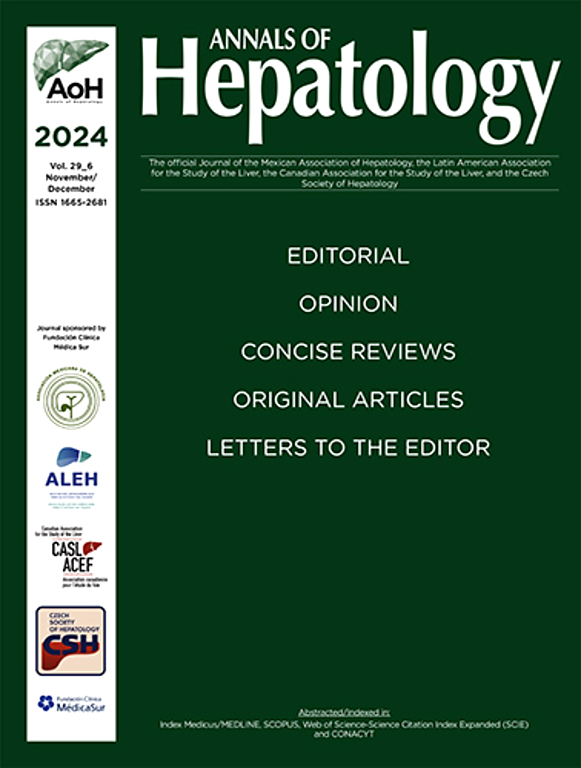2012 年至 2021 年加拿大艾伯塔省慢性乙型肝炎的流行病学和自然史:一项基于人口的研究。
IF 4.4
3区 医学
Q2 GASTROENTEROLOGY & HEPATOLOGY
引用次数: 0
摘要
简介和目标关于北美普通人群中慢性乙型肝炎(CHB)负担的最新数据非常有限。我们采用回顾性队列设计,检索了艾伯塔分析行政数据库(包括省级实验室数据库),以描述 2012-2020 财年期间加拿大艾伯塔省的慢性乙型肝炎流行病学和自然病史。我们使用泊松回归模型分析了发病率和患病率趋势,并进行了卡普兰-梅耶分析,以检验发病队列的存活率。结果2015-2020年间,经年龄/性别调整后的CHB发病率为27.1/100,000人/年(男性为29.6/100,000,女性为24.5/100,000),45-64岁人群的发病率最高。尽管 2015-2020 年间慢性阻塞性肺病的年发病率从每 10 万人 36.4 例降至 13.4 例,但同期患病率却从每 10 万人 98.9 例增至 210.3 例。在6860例发病病例中,2.1%的患者死亡,0.2%的患者接受了肝移植手术,中位随访时间为3.6年(四分位间范围为2.0-4.9年)。与年龄/性别匹配的加拿大人相比,CHB 患者的存活率明显较低,标准化死亡率为 3.9(95% 置信区间 [CI] 3.3-4.6)。男性(危险比 [HR] 1.7; 95% CI 1.2-2.5)、诊断时年龄较大(HR,1.08; 95% CI 1.07-1.09)是预测死亡率的独立指标。男性和 45-64 岁人群的慢性阻塞性肺病发病率和流行率较高。CHB患者的存活率较低,这强调了有必要解决指南建议的HBV治疗联系障碍。本文章由计算机程序翻译,如有差异,请以英文原文为准。

Epidemiology and natural history of chronic Hepatitis B in the Canadian province of Alberta from 2012 to 2021: A population-based study
Introduction and Objectives
There are limited recent data on the burden of chronic hepatitis B (CHB) in the North American general population. We aimed to identify the CHB burden from a Canadian population-based perspective.
Patients and Methods
Using a retrospective cohort design, we searched Alberta Analytics administrative databases including the Provincial Laboratory database, to describe CHB epidemiology and natural history in Alberta, Canada between fiscal years 2012-2020. We analyzed incidence and prevalence trends using a Poisson regression model and conducted Kaplan-Meier analyses to examine the incident cohort's survival.
Results
The age/sex-adjusted incidence of CHB between 2015-2020 was 27.1/100,000 person/years (29.6/100,000 in males and 24.5/100,000 in females) and was highest among individuals aged 45-64 years. Despite a decrease in annual incidence of CHB from 36.4 to 13.4/100,000 between 2015-2020, prevalence increased from 98.9 to 210.3/100,000 in the same period. Of 6,860 incident cases, 2.1% died, and 0.2% underwent liver transplantation during a median follow-up of 3.6 years (interquartile range 2.0-4.9 years). CHB patients had significantly lower survival rates compared to age/sex-matched Canadians, with a standardized mortality ratio of 3.9 (95% confidence interval [CI] 3.3-4.6). Male sex (hazard ratio [HR] 1.7; 95% CI 1.2-2.5), older age at diagnosis (HR, 1.08; 95% CI 1.07-1.09) independently predicted mortality.
Conclusions
CHB incidence decreased in Alberta, which is consistent with nationwide trends. Males and individuals aged 45-64 had higher CHB incidence and prevalence. CHB patients’ lower survival rates emphasize the need to address barriers to guideline recommended HBV care linkage.
求助全文
通过发布文献求助,成功后即可免费获取论文全文。
去求助
来源期刊

Annals of hepatology
医学-胃肠肝病学
CiteScore
7.90
自引率
2.60%
发文量
183
审稿时长
4-8 weeks
期刊介绍:
Annals of Hepatology publishes original research on the biology and diseases of the liver in both humans and experimental models. Contributions may be submitted as regular articles. The journal also publishes concise reviews of both basic and clinical topics.
 求助内容:
求助内容: 应助结果提醒方式:
应助结果提醒方式:


